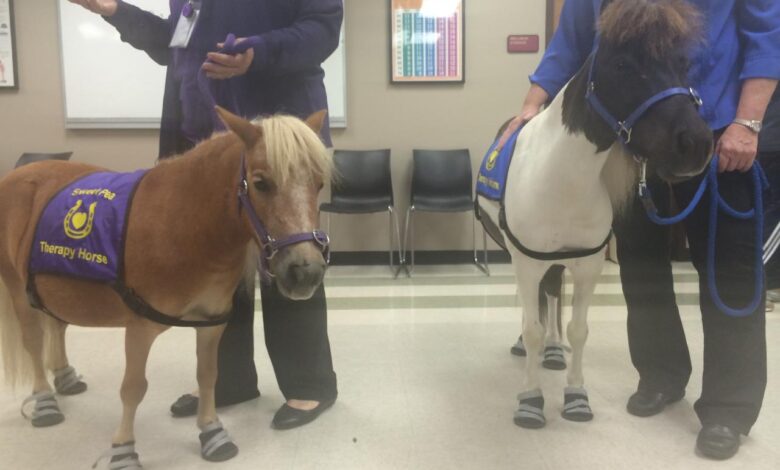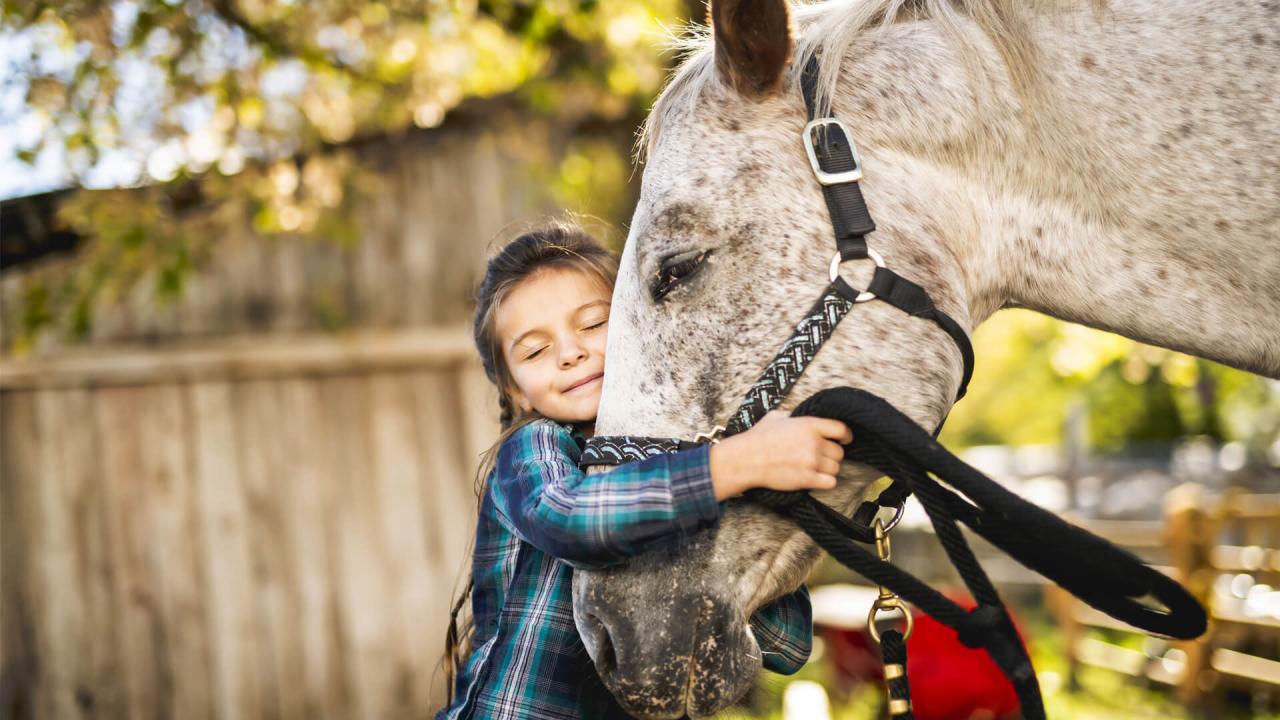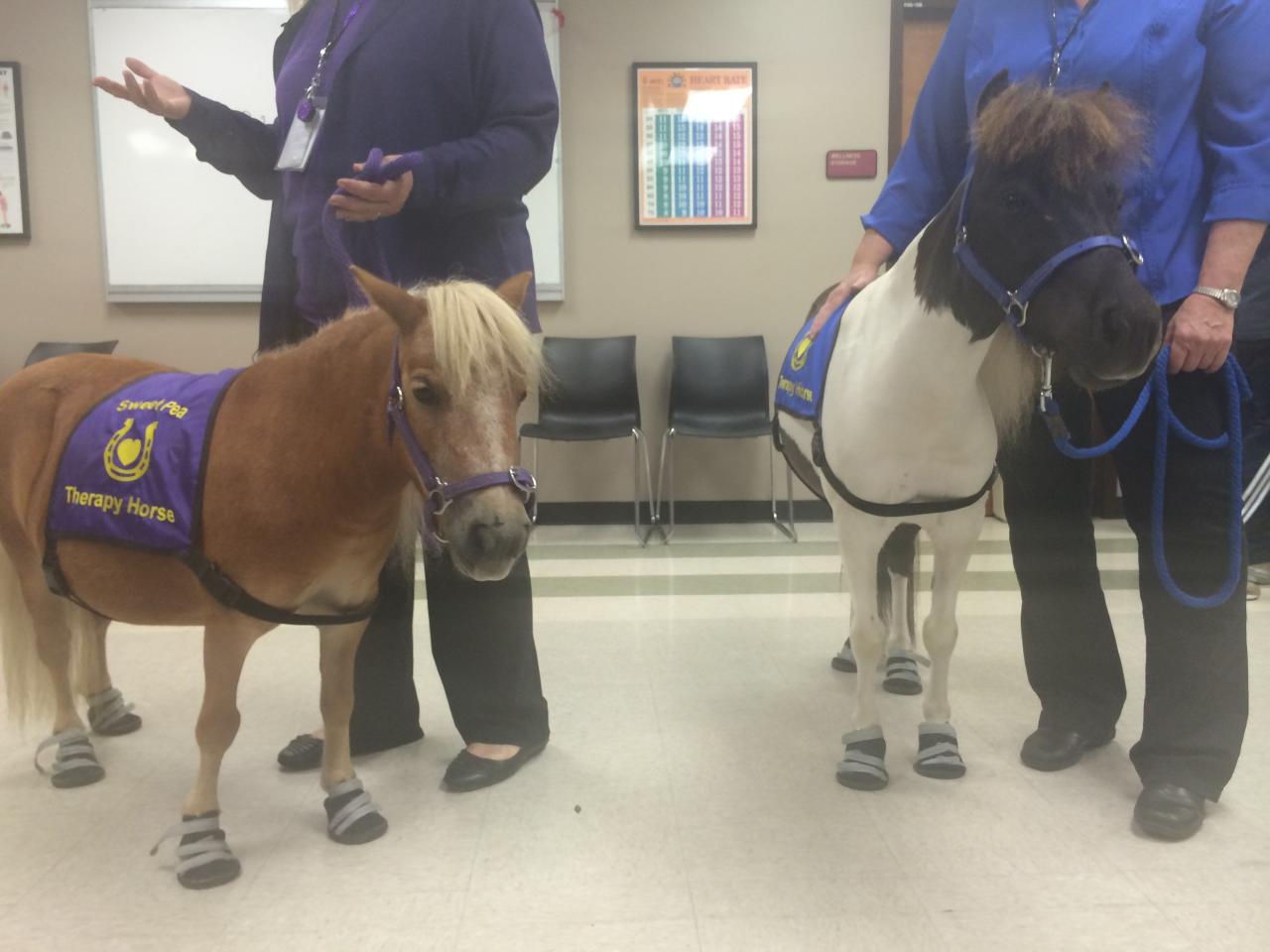
Harnessing the Healing Power of Horses
Harnessing the healing quality of horses offers a unique approach to well-being, drawing on the remarkable connection between humans and equines. This exploration delves into the historical, physiological, and psychological benefits of equine-assisted therapy (EAT), uncovering the transformative potential of this ancient practice. We’ll examine various EAT programs, their diverse applications, and the critical role horses play in these therapeutic interactions.
From stress reduction to emotional regulation, EAT has the potential to empower individuals to overcome personal challenges.
This in-depth look at equine-assisted therapy will cover everything from the historical context and different types of programs to the specific physiological and psychological benefits. We’ll also explore the practical application, ethical considerations, case studies, and future trends in this fascinating field. Get ready to discover how the gentle touch and presence of horses can unlock healing and personal growth.
Introduction to Equine-Assisted Therapy
Equine-assisted activities and therapies (EAAT) encompass a broad spectrum of programs that leverage the unique qualities of horses to facilitate personal growth and healing. These programs have a rich history, evolving from traditional uses of horses in agriculture and transportation to modern therapeutic applications. The core principle of EAAT rests on the idea that interaction with horses can foster a sense of connection, responsibility, and self-awareness, positively impacting emotional, physical, and cognitive well-being.The use of horses for therapeutic purposes has ancient roots.
From ancient civilizations to the present day, horses have been recognized for their calming presence, their ability to provide a sense of grounding, and their capacity to challenge and motivate individuals. This ancient wisdom is now harnessed in modern therapeutic settings to create meaningful, lasting change.
Types of Equine-Assisted Activities and Therapies
EAAT programs come in various forms, each tailoring the interaction with horses to specific needs. These programs often incorporate a variety of activities, from simple grooming and leading to more challenging exercises like riding. The diverse range of programs reflects the adaptability and versatility of equine-assisted interventions.
Roles of Horses in EAAT Programs
Horses play a multifaceted role in EAAT programs. They serve as a powerful catalyst for personal growth and change, impacting participants in profound ways. Horses provide a non-judgmental environment, enabling individuals to explore emotions and develop coping mechanisms. Their presence encourages participants to develop trust and responsibility, while their movements and reactions can provide opportunities for individuals to gain a deeper understanding of themselves.
Different EAAT Program Types and Variations
Different EAAT programs vary in their specific activities and the target populations they serve. These programs can range from recreational activities designed to improve overall well-being to structured therapies addressing specific mental health conditions. The types and variations in EAAT programs are designed to meet the specific needs of each participant.
| Therapy Type | Description | Key Benefits |
|---|---|---|
| Equine-Assisted Psychotherapy | Utilizes the horse as a facilitator for therapeutic exploration of emotions, behaviors, and relationships. It can be used to address a variety of issues, including anxiety, depression, trauma, and self-esteem issues. | Improved emotional regulation, increased self-awareness, development of coping mechanisms, and enhanced communication skills. |
| Equine-Assisted Learning | Focuses on developing specific skills and knowledge, often within educational settings. It can be utilized to enhance cognitive functions, build confidence, and improve social skills. | Improved communication skills, increased confidence and self-esteem, enhanced problem-solving abilities, and development of leadership skills. |
| Equine-Assisted Activities | These activities encompass a range of interactions with horses, such as grooming, leading, and riding. They are often recreational and aim to improve physical and mental well-being. | Improved physical fitness, reduced stress levels, increased self-esteem, and development of empathy and responsibility. |
Physiological Benefits of Interaction
Interacting with horses can have profound physiological effects on humans, extending beyond the emotional well-being often discussed. The calm and rhythmic nature of horses, combined with the physical activity and mindful presence required for interaction, can contribute to measurable improvements in various aspects of human health. These benefits are particularly relevant in therapeutic settings, where they can complement existing treatments and foster holistic healing.The physical and emotional connection with a horse can trigger a cascade of physiological responses that promote relaxation and well-being.
Studies show that simply being in the presence of horses can lower stress hormones and elevate mood-boosting neurochemicals. This is not simply anecdotal; the physiological mechanisms underlying these changes are scientifically verifiable and offer a deeper understanding of the therapeutic potential of equine interaction.
Stress Reduction Mechanisms
The presence of horses has a calming effect on the human nervous system. The rhythmic nature of equine movement, the quiet environment, and the focus required for interaction can help lower cortisol levels, a hormone associated with stress. Studies have shown significant reductions in cortisol levels in individuals participating in equine-assisted activities. This calming effect is further enhanced by the release of oxytocin, often referred to as the “love hormone,” which promotes feelings of connection and trust.
Improved Cardiovascular Health, Harnessing the healing quality of horses
Equine-assisted activities can contribute to improved cardiovascular health through increased physical activity. Gentle interaction, such as leading or grooming, and even simply being in the presence of horses, can promote relaxation, reduce blood pressure, and improve heart rate variability. This positive effect on the cardiovascular system is crucial for individuals with pre-existing conditions, potentially providing an alternative or complementary approach to traditional cardiovascular rehabilitation programs.
The moderate physical activity inherent in these interactions can enhance cardiovascular fitness without the strenuous demands of other forms of exercise.
Comparison to Other Therapeutic Approaches
While other therapies such as yoga or meditation also promote relaxation and stress reduction, equine-assisted therapy often offers a unique element of connection and shared experience with a large, living animal. This connection can enhance the therapeutic effect and foster a sense of empowerment and accomplishment in participants. The focus and mindfulness required for interaction with a horse can create a unique space for self-reflection and emotional processing.
Table of Physiological Benefits and Mechanisms
| Physiological Benefit | Mechanism | Relevant Research Studies |
|---|---|---|
| Stress Reduction | Reduced cortisol levels, increased oxytocin, and calming effects of rhythmic movement. | Numerous studies on equine-assisted therapy have documented these effects. Specific studies can be located in academic databases such as PubMed. |
| Improved Cardiovascular Health | Increased physical activity, reduced blood pressure, improved heart rate variability, and overall relaxation. | Research on equine-assisted activities and their impact on cardiovascular parameters is ongoing, with preliminary studies showing promising results. |
| Enhanced Emotional Well-being | Increased feelings of connection, trust, and empowerment through interaction with a large animal. | Qualitative studies and case reports often describe the emotional benefits, but further research is needed to quantify these effects. |
Psychological Impacts of Equine Interaction

The gentle presence of a horse can have a profound impact on an individual’s psychological well-being. Equine-assisted therapy leverages the unique connection between humans and horses to facilitate healing and growth. This interaction, often described as a non-judgmental and accepting relationship, provides a powerful platform for addressing emotional and psychological challenges. It creates a space where individuals can explore their inner world without fear of criticism or judgment.Equine interaction fosters a sense of responsibility and empathy, often absent in traditional therapy settings.
The horse’s needs and responses necessitate attentiveness and patience, prompting introspection and emotional regulation skills in participants. This unique therapeutic modality can significantly improve self-esteem, confidence, and emotional regulation, ultimately helping individuals navigate their lives with greater resilience and emotional intelligence.
Improved Self-Esteem and Confidence
Horses, through their non-verbal communication, offer valuable feedback without explicit criticism. This creates a safe environment for individuals to explore their strengths and overcome perceived weaknesses. Successfully completing tasks alongside the horse, from leading it to grooming it, builds a sense of accomplishment and competence, directly boosting self-esteem. The act of caring for a horse instills a sense of responsibility, further enhancing self-worth and confidence.
Emotional Regulation
The rhythmic nature of equine movement, combined with the horse’s sensitivity to subtle cues, can help individuals develop greater awareness of their own emotional responses. By observing the horse’s reactions, participants learn to identify and manage their emotions more effectively. The therapeutic process fosters emotional regulation skills, allowing individuals to respond to challenging situations with greater composure and emotional intelligence.
Overcoming Psychological Challenges
Equine-assisted therapy can prove beneficial for individuals facing various psychological challenges. For instance, those with anxiety disorders may find the controlled environment and the non-judgmental nature of equine interaction particularly helpful in reducing anxiety symptoms. Similarly, individuals struggling with trauma or PTSD can benefit from the calming presence of the horse and the opportunity to build trust and safety in a new context.
Individuals experiencing depression can benefit from the focus on positive actions, such as caring for the horse, and the opportunity to develop a sense of accomplishment and responsibility.
Potential Psychological Barriers
While equine-assisted therapy offers numerous benefits, potential psychological barriers can arise. Fear of horses, past negative experiences with animals, or a lack of trust in the therapeutic process can hinder progress. Furthermore, participants who are struggling with intense emotional distress may find the environment overwhelming or triggering.
Psychological Benefits, Challenges, and Coping Strategies
| Psychological Benefit | Related Challenges | Effective Coping Strategies |
|---|---|---|
| Improved Self-Esteem | Fear of failure, self-doubt, lack of confidence | Positive self-talk, setting realistic goals, focusing on progress, celebrating achievements |
| Enhanced Emotional Regulation | Difficulty identifying emotions, impulsivity, inability to manage distress | Mindfulness exercises, deep breathing techniques, journaling, active listening during sessions |
| Reduced Anxiety | Overthinking, fear of the unknown, overwhelming sensory input | Grounding techniques, controlled exposure to horses, progressive desensitization |
| Trauma Processing | Flashbacks, intrusive thoughts, avoidance behaviors | Establishing a safe therapeutic environment, gradual exposure to equine interaction, support from the therapist |
Practical Application and Methods: Harnessing The Healing Quality Of Horses
Equine-assisted therapy (EAT) isn’t just about hanging out with horses; it’s a structured, therapeutic process. This section delves into the practical application, outlining how trained professionals guide interactions to maximize therapeutic benefits. We’ll explore the specific methods, the session structure, and the crucial role of the therapist.The core of equine-assisted therapy lies in the carefully designed interaction between client and horse.
The horse, as a powerful and sensitive being, provides a unique opportunity for clients to explore emotions, develop coping mechanisms, and build self-awareness. This section emphasizes the crucial role of trained professionals in creating a safe and supportive environment for this process to unfold.
Structuring a Therapy Session
A typical EAT session isn’t a free-for-all; it’s a meticulously planned sequence of activities, each designed to foster specific therapeutic goals. The structure of the session is critical in ensuring optimal engagement and progress. This involves clear objectives, carefully chosen activities, and consistent monitoring by the therapist.
Role of Trained Professionals
Therapists in equine-assisted therapy programs are not just facilitators; they are skilled professionals who understand both human psychology and equine behavior. They are responsible for assessing client needs, creating individualized plans, and ensuring a safe and productive therapeutic environment. This involves understanding the client’s background, their goals, and the appropriate methods to support their growth. A deep understanding of the horse’s temperament and capabilities is equally crucial.
Their training enables them to interpret the horse’s subtle cues and tailor interactions accordingly, ensuring the client’s comfort and safety.
Harnessing the healing power of horses is truly remarkable. It’s fascinating how equine interaction can positively impact mental well-being, fostering a sense of calm and connection. This mindful approach to therapy, in combination with the power of human connection, can lead to truly incredible results. For example, exploring the diverse aspects of this field, including the impact on children and adults, is explored further in the exciting new exploration of Hello world!.
This new insight on a deeper level helps us understand how harnessing the therapeutic qualities of horses can transform lives.
Methods and Techniques in EAAT Programs
Several methods are used in equine-assisted therapy to encourage client growth. These methods often involve interaction with the horse through activities like leading, grooming, and participating in ground work exercises. These activities are designed to build trust, improve self-esteem, and enhance emotional regulation. The therapist carefully guides the interaction, providing verbal support and encouragement. These interactions are closely observed, and feedback is tailored to individual needs.
Phases of an EAAT Session
Equine-assisted therapy sessions are typically divided into distinct phases, each with its own set of activities and therapeutic goals. This structured approach allows for focused engagement and maximum benefit.
| Phase | Activities | Therapeutic Goals |
|---|---|---|
| Assessment and Rapport Building | Initial interaction with the horse, focusing on observation and building trust. Includes grooming, handling, and light ground work. | Establishing a safe and comfortable environment. Building trust between the client and the horse. Recognizing the client’s strengths and areas for development. |
| Guided Activities | Structured exercises with the horse, like leading, mounting (if appropriate), or participating in ground work. | Developing emotional regulation skills, enhancing self-esteem, improving communication, and exploring coping mechanisms. |
| Reflection and Processing | Discussion and analysis of the experience with the horse. The therapist facilitates reflection on feelings and behaviors. | Gaining insight into the client’s emotional responses, promoting self-awareness, and connecting experiences with personal life. |
Ethical Considerations and Safety Protocols
Equine-assisted therapy, while offering profound benefits, demands unwavering attention to ethical considerations and safety protocols. These are not mere add-ons but fundamental components ensuring the well-being of both human participants and the horses involved. A robust framework of ethical principles and safety procedures safeguards the therapeutic process, fosters trust, and ultimately enhances the positive impact on all parties.Equine-assisted therapy necessitates a commitment to the ethical treatment of animals and the safeguarding of human participants.
Harnessing the healing qualities of horses is fascinating, and it’s a powerful concept. Just like the equine therapy field, the future of sustainable energy looks to alternative materials, like bio-based plastics, to reduce our environmental footprint. This innovative approach, much like the carefully crafted equine-assisted therapy programs, offers a pathway towards a healthier planet and a more holistic approach to well-being, for both humans and animals.
It’s all part of a larger movement to embrace natural solutions. the future of sustainable energy looks to alternative materials Ultimately, both fields highlight the profound healing potential of nature and human connection.
Prioritizing the well-being of the horses, ensuring participant safety, and resolving ethical dilemmas are crucial to the integrity and effectiveness of the therapy. This section will delve into the critical importance of these elements in equine-assisted therapy.
Importance of Ethical Considerations
Ethical considerations in equine-assisted therapy encompass a broad range of principles, primarily focusing on the welfare of both humans and horses. The therapeutic relationship is built on trust and mutual respect. A strong ethical framework ensures that the interaction between participants and horses is positive and beneficial for all involved. This includes considering the horses’ emotional and physical needs, and ensuring the therapy sessions are conducted in a manner that minimizes stress and maximizes positive experiences for the animals.
Safety Protocols for Participants
Participant safety is paramount in equine-assisted therapy. Comprehensive safety protocols are crucial for minimizing risks. These protocols should include proper training and supervision of participants, clear communication, and risk assessment procedures. All participants should be assessed for suitability and receive appropriate instruction in interacting with horses. Detailed guidelines for handling and mounting horses, as well as emergency procedures, are critical to the process.
Safety Protocols for Horses
Horse safety is equally important. Procedures must ensure the horses’ physical and mental well-being. This includes thorough veterinary checks, appropriate conditioning, and careful consideration of the horses’ temperament and experience level. Horses should be matched with participants based on compatibility and experience, ensuring a safe and positive experience for both. Monitoring the horses’ responses during sessions is essential, allowing for immediate adjustments if needed.
Equine Well-being in the Therapeutic Process
The well-being of the horses is intrinsically linked to the success of the therapy. A stressed or unhappy horse can negatively impact the participant’s experience. Recognizing and addressing the horses’ physical and emotional needs is crucial. This includes providing adequate rest, proper nutrition, and a safe environment. Horses should be allowed to exhibit natural behaviors and should not be forced into situations that cause them distress.
Ethical Dilemmas and Resolution Strategies
Ethical dilemmas can arise in equine-assisted therapy. For example, a participant may exhibit aggressive behavior toward a horse, or a horse might display signs of distress. Such situations require careful assessment and a pre-determined protocol for resolution. Effective communication, clear guidelines, and a multidisciplinary approach are essential for resolving these situations. These situations necessitate prompt action, addressing the underlying issues and preventing future occurrences.
Table of Ethical Considerations
| Ethical Consideration | Potential Issue | Solution |
|---|---|---|
| Participant Safety | Participant acting inappropriately with horse | Immediate intervention, redirection, and follow-up discussion |
| Horse Welfare | Horse exhibiting signs of distress | Immediate cessation of session, veterinary consultation, and review of handling techniques |
| Confidentiality | Participant revealing sensitive information | Reinforcing confidentiality protocols, ensuring privacy during sessions |
| Informed Consent | Lack of clarity on the therapeutic process | Providing comprehensive information, obtaining written consent |
Case Studies and Examples

Equine-assisted therapy (EAT) offers a unique approach to healing, leveraging the calming presence and powerful influence of horses. This section explores real-life examples demonstrating the positive impact of EAT on various individuals, showcasing how this therapeutic method can address specific challenges and promote personal growth. These case studies highlight the effectiveness and versatility of EAT, emphasizing the significant improvements observed in participants’ lives.Understanding the nuanced impact of EAT requires looking at specific cases.
Each individual’s journey is unique, reflecting the tailored nature of the therapy. The following examples demonstrate how EAT can facilitate emotional processing, enhance self-awareness, and promote improved social interaction.
Case Study 1: Overcoming Anxiety
“Before beginning EAT, Sarah experienced significant anxiety that hampered her daily activities. Through gentle interaction with horses, she developed a sense of calmness and control she hadn’t felt before. She reported decreased feelings of panic and improved sleep quality.”
Sarah’s experience illustrates how EAT can be particularly effective in managing anxiety. The therapeutic relationship with the horse, built on trust and mutual respect, can provide a safe space for individuals to explore and process their anxieties in a supportive environment. This approach can be especially valuable for those struggling with anxiety disorders.
Case Study 2: Fostering Self-Esteem in Adolescents
“A group of teenagers participating in EAT sessions reported increased self-esteem and confidence. Through observing and interacting with the horses, the teens developed a sense of accomplishment and learned to communicate more effectively with others.”
This example demonstrates how EAT can be beneficial for adolescents. The program provided a safe and encouraging environment where the teens could explore their strengths, build confidence, and improve their social skills. By fostering positive self-perception and encouraging collaboration with peers, EAT can have a profound impact on their overall well-being.
Case Study 3: Enhancing Communication Skills
“A client with autism spectrum disorder experienced significant improvement in communication skills after participating in EAT. The structured interactions with horses facilitated the development of non-verbal communication and improved the client’s ability to engage in social interactions.”
This case study highlights the potential of EAT to address specific needs, such as improving communication skills in individuals with autism spectrum disorder. The program helped to facilitate the development of non-verbal cues and improved social interaction, providing a tangible demonstration of the therapy’s ability to address individual needs.
Case Study 4: Addressing Trauma
“A veteran struggling with PTSD found solace and healing through EAT. The therapeutic interactions with horses provided a safe and supportive environment to process past traumas, leading to a reduction in symptoms and improved emotional regulation.”
This case demonstrates the potential of EAT to address trauma. The therapeutic environment provided a safe space for the veteran to process past trauma, leading to significant improvements in emotional regulation and symptom reduction. This highlights the importance of tailored support and a patient-centered approach.
Future Trends and Developments

The field of equine-assisted therapy is poised for exciting growth and evolution. Advancements in understanding the human-animal bond and the therapeutic properties of equine interaction are driving innovative approaches to treatment and well-being. This dynamic field is likely to see greater integration with other therapies, leading to more comprehensive and effective interventions.
Emerging Trends in Equine-Assisted Therapy
Equine-assisted therapy is increasingly incorporating technology to enhance the therapeutic experience. This includes the use of wearable sensors to monitor physiological responses during interactions, allowing for more precise assessment and tailored interventions. Virtual reality (VR) and augmented reality (AR) are also being explored, offering the potential to create immersive and engaging therapeutic environments. These advancements may increase accessibility and broaden the reach of equine-assisted therapy, potentially offering new avenues for treatment in remote areas or for individuals with mobility limitations.
Integration with Other Therapeutic Modalities
Equine-assisted therapy shows strong potential for integration with other therapeutic approaches. This could involve combining equine interaction with cognitive behavioral therapy (CBT) to address specific psychological challenges, or with physical therapy to improve motor skills and physical function. For instance, a patient experiencing anxiety might benefit from a combined approach, using equine-assisted interaction alongside CBT techniques to manage their emotional responses.
This integrative approach allows for a holistic and targeted intervention plan.
Future Research Directions
The future of research in equine-assisted therapy will likely focus on refining assessment tools and expanding the understanding of the mechanisms by which horses influence human well-being. Researchers are actively investigating the specific physiological and psychological changes that occur during equine interactions, potentially identifying biomarkers that can be used to track progress and tailor interventions more effectively. The role of the equine-assisted therapist’s skills and experience in facilitating positive outcomes will also be investigated.
Potential Future Research Areas
- Developing standardized assessment tools to measure the effectiveness of equine-assisted therapy across various populations and settings. This includes establishing baseline measures and tracking changes over time in physiological responses, emotional states, and behavioral patterns.
- Investigating the long-term impact of equine-assisted therapy on physical and mental health outcomes. Longitudinal studies are needed to assess sustained benefits and identify potential factors that influence the effectiveness of the therapy over time. Case studies and observational studies can provide valuable data.
- Examining the specific role of the equine-therapist’s interaction style and communication strategies in achieving therapeutic outcomes. This includes evaluating the importance of non-verbal cues and communication methods.
- Exploring the use of equine-assisted therapy in treating specific populations, such as individuals with autism spectrum disorder, traumatic brain injury, or chronic pain conditions. Tailoring approaches to these specific needs will be a key focus.
- Assessing the impact of different equine breeds and personalities on therapeutic outcomes. Investigating the correlation between equine temperament and the therapeutic responses of participants will offer valuable insights into the horse-human interaction.
Projected Growth and Impact
The future growth of equine-assisted therapy is predicted to be significant. The increasing awareness of the therapeutic value of animals, combined with the growing demand for holistic and personalized interventions, will likely drive further adoption of this approach. This could lead to a wider range of services offered in hospitals, schools, and community centers, benefiting individuals from diverse backgrounds and circumstances.
For example, equine-assisted therapy programs are already being successfully integrated into rehabilitation centers, offering patients a unique pathway to recovery.
Concluding Remarks
In conclusion, harnessing the healing quality of horses is a powerful and multifaceted approach to well-being. From the historical roots of this practice to the modern-day applications and future potential, the journey of equine-assisted therapy is both inspiring and profound. The unique bond between humans and horses, coupled with professional guidance, creates a potent therapeutic environment. We hope this exploration has sparked your curiosity and highlighted the remarkable potential of this healing modality.

